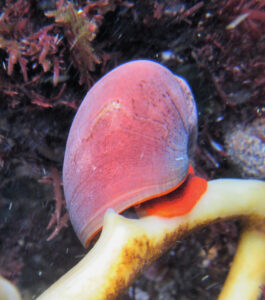Norris Top Shell, Norrisia norrisii
 Norris Top Shell, Norrisia norrisii. Underwater photograph taken in coastal waters of the greater San Diego, California area, May 2018. Photograph and identification courtesy of Bob Hillis, Ivins, Utah.
Norris Top Shell, Norrisia norrisii. Underwater photograph taken in coastal waters of the greater San Diego, California area, May 2018. Photograph and identification courtesy of Bob Hillis, Ivins, Utah.
Phylogeny: The Norris Top Shell, Norrisia norrisii (G.B. Sowerby I, 1828), is a gastropod mollusk that is a member of the Tegulidae Family of Top Shells. The genus Norrisia is one of eight genera in this family, and this is the only species in this genus. They are also known as the Norris Top Snail, the Smooth Brown Turban Snail, the Mexican Redfoot Snail, and the Kelp Snail and in Mexico as Caracol de Norris. This shell was named in honor of Thomas Norris, the English naturalist.
Description: The Norris Top Shell is solid, wide, and circular in profile. It has a very low spire and a smooth external surface. The exterior of the shell is reddish-brown to brown in color. The umbilicus is ringed with black. The columella (area between the umbilicus and aperture) is green. The operculum is brown and horn-like. The living animal is reddish-orange. Norris Top Shells reach a maximum of 6.7 cm (2.6 inches) in diameter.
Habitat and Distribution: Norris Top Shells are found on hard substrates, and are often associated with kelp forests. They live in the lower intertidal zone and to depths up to 36 m (120 feet). They are a temperate to subtropical Eastern Pacific species. They are found in Mexican waters of the Pacific Ocean but are limited to west coast of the Baja Peninsula from the northern border to Asuncion Island, Baja California Sur.
Ecology and Behavior: Norris Top Shells are herbivorous grazers that feed primarily on brown algae. They are prey for sea stars, octopuses, moon snails, and spiny lobsters. They are gonochoric and reproduce sexually, through broadcast spawning, with external fertilization. Norris Top Shells are known to host the parasitic flatworm Boonea cincta. They also host various epibionts including algae, barnacles and the Norrisia Slipper Shell, Crepidula norrisiarum. Empty Norris Top Shells are used by hermit crabs for housing. From a conservation perspective they have not been formally evaluated however they are fairly common with a relatively wide distribution and should be considered to be of Least Concern.
Synonyms: Trochiscus norrisii.